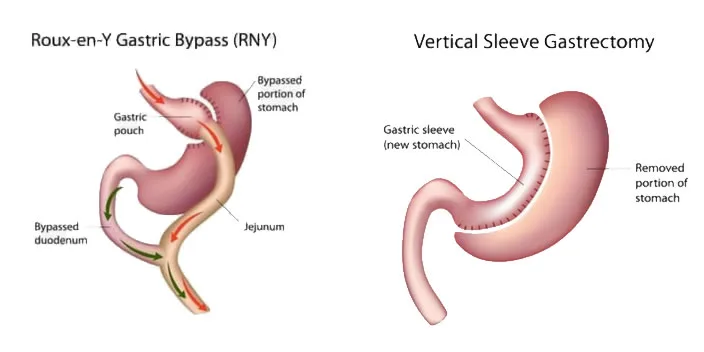Obesity Surgery
Obesity surgery refers to surgical procedures performed to treat excessive weight and fat accumulation. Obesity is a disease that occurs as a result of fat accumulation in the body to an extent that harms health. A person is considered obese if their body weight is 20% or more above the normal weight. Individuals with a Body Mass Index (BMI) between 25 and 29.9 are classified as overweight, while those with a BMI of 30 or higher are considered obese. Obesity surgery is generally performed on people who have been unable to lose weight through traditional methods or when other treatment options have proven insufficient. Surgical methods reduce the size of the stomach or make changes to the digestive system to help the person eat less.

Why Do People Become Obese?
Obesity generally results from a combination of several different factors. The main reasons why people become obese are:
Excess Calorie Intake: Consuming high-calorie foods excessively causes the body to take in more calories than it burns. This excess energy is stored as fat in the body.
Sedentary Lifestyle: Lack of physical activity prevents the body from burning excess calories, leading to fat accumulation.
Insufficient Sleep: Inadequate sleep disrupts hunger hormones, making a person prone to overeating.
Foods That Impair Lipid Metabolism: Foods high in saturated fats and sugars negatively affect fat metabolism, causing fat to accumulate.
Endocrine Disorders: Hormonal imbalances, such as thyroid problems, are among the causes of obesity.
Obesity is also associated with various diseases:
Bone and Cartilage Degeneration (Osteoarthritis): Being overweight places extra stress on joints, leading to joint diseases.
Coronary Heart Diseases: Obesity is a significant risk factor for heart diseases.
Gallbladder Diseases: Obesity increases the incidence of gallstones and gallbladder diseases.
High Cholesterol and High Triglycerides (Dyslipidemia): Excess weight raises cholesterol and triglyceride levels, increasing the risk of heart diseases.
Respiratory Problems and Sleep Apnea: Obesity can cause respiratory issues and sleep apnea.
Hypertension: Obesity is one of the main causes of high blood pressure.
Type 2 Diabetes: Obesity increases the risk of type 2 diabetes by causing insulin resistance.
Various Cancer Types: Obesity increases the risk of certain cancers, especially breast, colon, and pancreatic cancers.
If untreated, obesity can negatively affect overall quality of life in addition to these diseases.
Laparoscopic Obesity Surgery is a minimally invasive surgical technique preferred to speed up the patient’s recovery. In this procedure, surgeons make small incisions (5 mm – 10 mm) in the abdominal cavity and use small tube-like surgical tools called trocars to access inside. A small video camera (laparoscope) is placed inside the trocar, allowing the surgeon to watch a magnified view of the stomach and other internal organs on a TV screen.
During surgery, 5 to 6 small incisions are made for the effective use of special surgical instruments in the surgeon’s hand. All these operations are performed by inflating the abdominal cavity with carbon dioxide gas, which allows the surgeon to see organs more clearly and work over a larger area. At the end of the surgery, the gas inside the abdomen is released and the procedure is completed.
Advantages of laparoscopic surgery include smaller incisions, less bleeding, shorter hospital stays, and faster recovery. This method allows patients to return to normal life sooner.
Obesity Treatment involves several stages and requires a personalized plan for each patient. The basic treatment methods are:
Nutritional Changes: The first step in obesity treatment is changing eating habits. Obese patients are advised to reduce daily calorie intake and consume more fruits, vegetables, and whole grains. Balanced and varied nutrition is important, allowing different tastes and meals. The intake of sugar, refined carbohydrates, and high-fat foods should be significantly reduced.
Physical Activity: Regular physical activity speeds up weight loss. The more the body moves, the more calories it burns. About 8,000 calories need to be burned to lose 1 kg of fat. For obese patients, low to moderate activities like brisk walking are suitable initially. A combination of high physical activity and a good diet promotes controlled and significant weight loss.
Medication for Weight Loss: For patients who have difficulty losing weight through diet and exercise, medication can be an option. Medication treatment may be started if:
-
Other methods fail to achieve weight loss,
-
The patient’s Body Mass Index (BMI) is over 27 with health issues such as diabetes, hypertension, or sleep apnea,
-
BMI is 30 or above.
Medication supports weight loss but is usually used alongside diet and exercise and should only be started under a doctor’s recommendation.
Sleeve Gastrectomy (Tube Stomach Surgery)
The goal is to reduce stomach volume (to about 60-100cc) so the patient feels full with less food. For this, a portion of the stomach is surgically removed, leaving a tube-shaped stomach (about the size of a banana). It also reduces the production of the appetite-controlling hormone ghrelin, thus decreasing hunger. However, sleeve gastrectomy does not affect calorie and nutrient absorption in the intestines.
Gastric Bypass
Like sleeve gastrectomy, gastric bypass is usually performed laparoscopically. Through several small incisions, the surgeon reduces the stomach size. Unlike sleeve gastrectomy, gastric bypass creates a connection (anastomosis) between the stomach and the small intestine, which reduces nutrient absorption.
Sleeve gastrectomy reduces stomach volume only, while gastric bypass combines stomach reduction with bypassing part of the digestive tract, limiting nutrient absorption. This allows patients to feel full with less food and absorb fewer calories, promoting more weight loss.
Biliopancreatic Diversion – Duodenal Switch (BPD/DS) Surgery
BPD/DS is a highly effective obesity surgery, usually preferred in severe obesity cases. It begins with sleeve gastrectomy (removal of a large part of the stomach). Then, the middle part of the intestine is closed off, and the end part of the small intestine is connected to the duodenum (first part of the small intestine) — this is the “duodenal switch.”
The surgeon does not remove the closed part of the intestine but reroutes bile and pancreatic fluids to this segment. This arrangement, called biliopancreatic diversion, reduces nutrient absorption in addition to stomach reduction. Less calorie and nutrient absorption leads to more weight loss.
BPD/DS offers a combination of stomach reduction and intestinal bypass for larger and more lasting weight loss. Because it significantly reduces nutrient absorption, patients often need vitamin and mineral supplements.
Post-Surgery Weight Loss
Weight loss after surgery varies by the type of obesity surgery. Sleeve gastrectomy and gastric bypass have different success rates. Gastric bypass generally achieves higher weight loss compared to sleeve gastrectomy.
For example, after one year:
-
Sleeve gastrectomy results in about 40-50% weight loss,
-
Gastric bypass achieves about 65-70% weight loss.
Generally, weight loss continues for 18-24 months after surgery, with most weight loss in this period. Some patients may experience minor weight gain between 2 and 5 years as the body adjusts metabolically.
For successful results, patients must strictly follow recommended diet and exercise programs after surgery.
Who Is Suitable for Obesity Surgery?
Obesity surgery is generally recommended for:
-
People with a Body Mass Index (BMI) of 40 or higher (severe obesity),
-
People with BMI 35 or higher who also have serious health problems like hypertension, diabetes, or sleep apnea.
Obesity surgery aims to improve health, reduce obesity-related complications, and increase quality of life. The choice of surgery depends on examinations and specialist recommendations.
Patients are expected to have tried diet, exercise, and medical treatments before surgery.
Possible Complications
Laparoscopic obesity surgery is generally low risk, with mortality under 1%, but some complications can occur:
-
Wound infections or opening,
-
Abscesses and staple line leaks,
-
Intestinal rupture or obstruction,
-
Large stomach ulcers,
-
Pulmonary problems like pneumonia or breathing difficulties,
-
Deep vein thrombosis (blood clots in legs).
Postoperative Potential Issues:
-
Stomach pouch enlargement over time,
-
Persistent vomiting due to difficulty digesting food,
-
Stomach pain or inadequate weight loss.
Gastric Bypass Specific Complications:
-
Nutrient deficiencies (Vitamin B12, folate, iron) prevented by supplements,
-
Dumping syndrome (abdominal pain, cramps, sweating, diarrhea after eating sugary foods; avoid sugary foods to prevent symptoms),
-
Malabsorption and protein deficiency causing diarrhea and other issues.
These complications can be managed with careful monitoring, treatment, and supplements. Timely follow-up and intervention after surgery are crucial.
TREATMENTS

